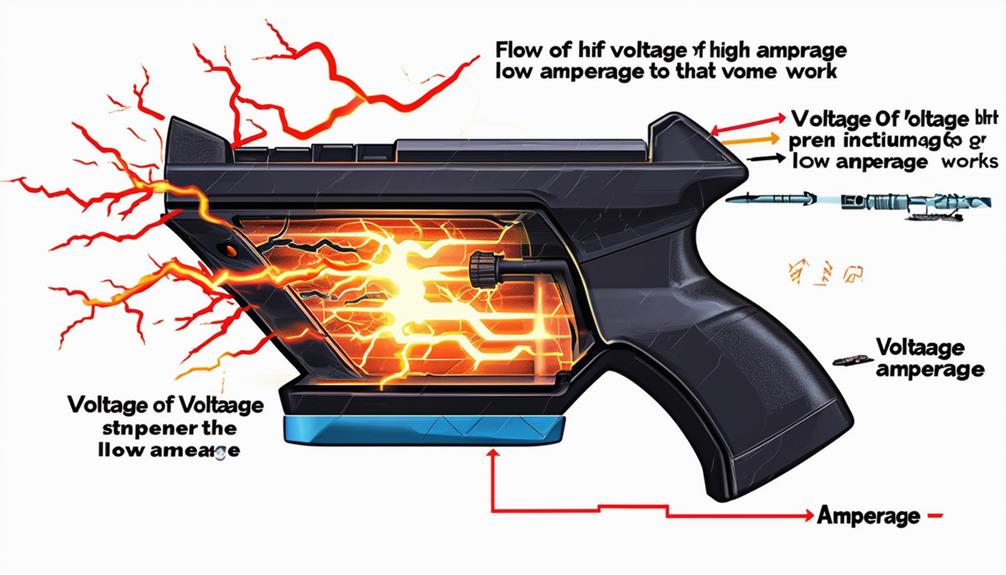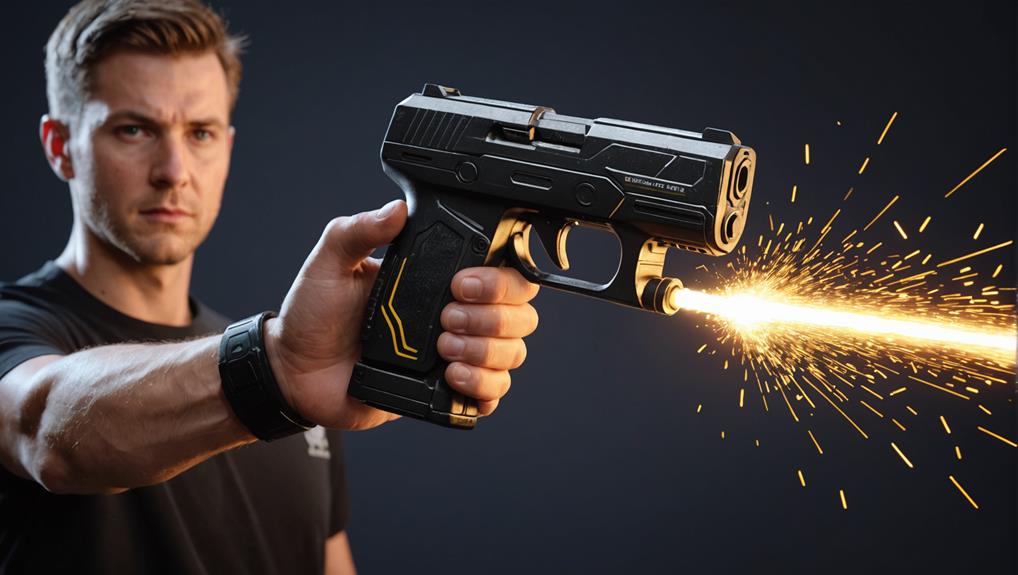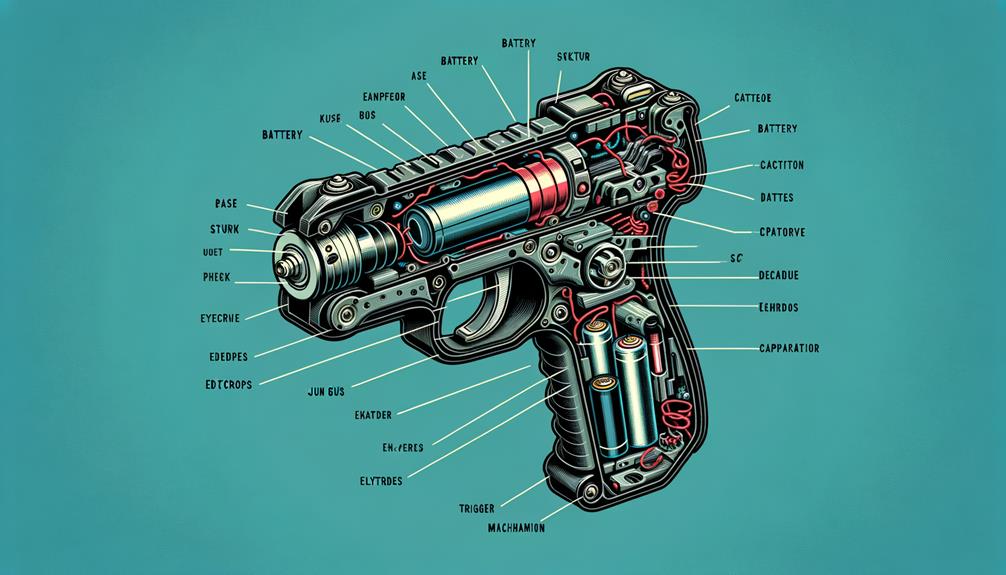
Brainstorm Security Shop

For Orders Over $199

On Any Of Our Products

Details On Refund Page
Imagine a device that can disrupt muscle function and nerve communication with a simple touch. Stun guns operate on a fascinating principle that involves manipulating the body’s electrical signals to induce temporary incapacitation. The intricate mechanisms behind these devices can make you wonder about the science and technology harnessed to create such an effective tool for self-defense. But how exactly do stun guns achieve this stunning effect, and how are stun gun vs taser differ?

When a stun gun’s electrodes make contact with the target, an electric shock is delivered that disrupts the normal function of muscles, causing temporary immobilization. The electric shock generated by a stun gun overrides the normal signals that control muscle movements in the body. This disruption results in the incapacitation of the target by preventing voluntary muscle control.
During the application of the electric shock, the muscle response is immediate. The electrical current interferes with the communication between the nerves and muscles, leading to a loss of control over muscle contractions. This sudden disruption causes the muscles to contract uncontrollably, leading to a state of temporary paralysis.
This immobilization effect is crucial in law enforcement and self-defense scenarios, providing a window of opportunity to subdue a target safely.
The electric shock delivered by a stun gun disrupts the normal communication between the nervous system and muscles, resulting in temporary incapacitation. When the stun gun’s electrodes come into contact with the body, they deliver a high-voltage, low-current electrical charge. This charge interferes with the nervous system’s ability to send and receive signals properly. The nerve disruption caused by the electric shock leads to a significant pain response in the individual targeted.
As the electrical current flows through the body, it induces muscle contractions due to the altered signals being sent along the nerves. The muscles may spasm uncontrollably in response to the disrupted communication between the nerves and the brain.
Additionally, the sensory overload experienced from the stun gun’s shock overwhelms the nervous system, causing confusion and disorientation. The combination of nerve disruption, pain response, muscle contraction, and sensory overload results in a state of temporary incapacitation, rendering the individual unable to function normally.
The high-voltage electricity delivered by a stun gun overwhelms the senses by inducing muscle contractions and disrupting nerve communication. When a stun gun makes contact with the body, the electrical current flows through the skin, encountering electrical resistance generated by the body’s tissues. This resistance causes the electricity to follow a path through the body, affecting the nervous system directly.
The neurological response to the electrical shock is immediate, sending signals throughout the body that interfere with normal nerve communication. This disruption leads to a rapid and involuntary muscle reaction, causing intense muscle contractions. These contractions aren’t under your control and contribute to the overwhelming sensation experienced during a stun gun encounter.
Individual pain tolerance and the specific location of the stun gun contact can influence the intensity of the overwhelming sensation. The combination of electrical resistance, neurological response, and muscle reaction is what ultimately overwhelms your senses when subjected to high-voltage electricity from a stun gun.
High-voltage electricity from a stun gun causes temporary incapacitation by disrupting nerve communication and inducing involuntary muscle contractions. When the prongs deliver the electrical current, it interferes with the normal electrochemical signals that travel along the nerves. This disruption overwhelms the nervous system, leading to a loss of control over muscle movement.
The effectiveness of a stun gun in causing temporary incapacitation varies based on factors like the voltage delivered and the duration of the shock. Typically, the incapacitation time can range from a few seconds to several minutes.
After the stun gun is deactivated, the recovery period begins. During this phase, the affected individual may experience muscle soreness and disorientation. It’s crucial to allow the person sufficient time to recover fully.
Understanding the stun gun’s impact on nerve communication and muscle function is essential in comprehending both its effectiveness and the temporary nature of the incapacitation it induces.

Disrupting nerve communication and inducing involuntary muscle contractions, stun guns target specific muscle groups by delivering high-voltage electricity through their prongs. When the electrical current makes contact with the body, it interferes with the normal communication between the brain and muscles. This disruption causes the muscles to contract uncontrollably, leading to intense pain responses due to the overstimulation of nerve endings.
As the stun gun continues to deliver electricity, the targeted muscle groups experience rapid fatigue as they work excessively. This muscle fatigue contributes to the temporary paralysis effect seen in individuals subjected to a stun gun shock.
The combination of muscle contractions, pain responses, and muscle fatigue results in a momentary loss of control over the affected areas, rendering the person incapacitated temporarily.
To prevent accidental discharge, stun guns are equipped with safety features that require deliberate activation before they can be used. Safety mechanisms play a crucial role in preventing unintended firing, ensuring that the stun gun is only discharged when intentionally triggered.
One common safety feature is a safety switch or button that must be engaged before the device can be operated. This switch is designed to prevent accidental activation and adds an extra layer of protection for the user.
Additionally, proper usage and handling instructions are essential to avoid accidental discharge. Users should familiarize themselves with the safety features of the stun gun and follow the manufacturer’s guidelines for operation.
Stun guns should be stored securely to prevent unauthorized access and handled with care to avoid unintentional activation. By understanding and adhering to the safety mechanisms and handling instructions, users can minimize the risk of accidental discharge and ensure the safe use of stun guns.

Understanding the relationship between voltage levels and the effectiveness of stun guns is essential for users to grasp the device’s functionality. Voltage regulation plays a crucial role in determining the stun gun’s impact on a target. Higher voltage levels typically result in more effective incapacitation of the target by disrupting the nervous system’s signals. However, it’s important to consider safety considerations, especially the potential impact on the heart.
Excessive voltage can lead to serious health risks, particularly for individuals with underlying heart conditions. Therefore, users must be cautious when selecting a stun gun with an appropriate voltage level to achieve the desired effectiveness without compromising safety.
When using stun guns, it’s imperative to be aware of the potential effects on the target’s heart. The electrical discharge can interfere with the heart’s normal rhythm, posing significant risks, especially in sensitive individuals. As such, understanding the relationship between voltage levels and the stun gun’s effectiveness is crucial for both achieving the desired outcome and ensuring the safety of all parties involved.
Consideration of legal aspects is paramount when using stun guns, particularly regarding regulations and restrictions on their use in various jurisdictions. Use restrictions are commonly in place to ensure stun guns are utilized solely for self-defense purposes. It’s crucial to understand the legal consequences associated with improper or unlawful use of stun guns, as such actions can have severe repercussions.
Stun guns are designed to be non-lethal weapons, emphasizing public safety. However, misuse or unauthorized use can lead to legal issues, including fines, penalties, or even criminal charges depending on the jurisdiction.
When considering the use of stun guns, it’s essential to familiarize yourself with the specific laws and regulations governing their use in your area. Some regions may have stringent guidelines on who can carry or use stun guns and the circumstances under which they can be deployed. Understanding these legal considerations is fundamental to ensure that stun guns are employed responsibly and within the boundaries of the law to uphold public safety and prevent legal ramifications.

Differentiating between stun gun vs Taser primarily lies in their operational mechanisms and design features. Stun guns are handheld devices that deliver an electric shock upon contact with an assailant, primarily used for self-defense. Their legality varies by state, with some permitting their use for personal protection.
In contrast, Tasers are electroshock weapons that fire two barbed darts attached to conductive wires, allowing for a distance between the user and the target. Tasers are commonly used in law enforcement due to their ability to incapacitate a subject from a safer distance.
Regarding technology, stun guns require direct contact to deliver the shock, while Tasers use a mechanism that shoots probes up to 15 feet away. Stun guns are limited by their close-range nature, whereas Tasers offer a more extended reach, making them valuable in law enforcement scenarios.
When considering self-defense, stun guns are suitable for close encounters, while Tasers provide a non-lethal option for immobilizing threats at a distance.
In conclusion, stun guns immobilize muscles by delivering an electric shock that disrupts nerve communication, overwhelms the senses, and induces temporary incapacitation.
By targeting specific muscle groups, these devices provide a means of self-defense in close encounters.
Safety features prevent accidental discharge, and understanding the voltage levels and legal considerations is crucial.
Different from tasers, stun guns are effective tools for personal protection in dangerous situations.

Brainstorm Security Shop
1867 Caravan Trail
Ste 105
Jacksonville, FL 32216
Call us toll free: (800) 859-5566